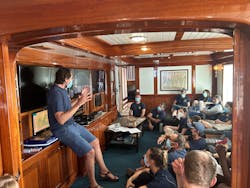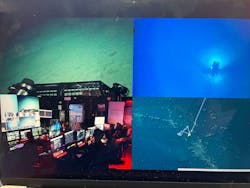Robotic vehicle plunges into ocean exploration with an optical sensing platform
What better way to study something than to get right up close to it? That’s exactly what a team from the SETI Institute (Mountain View, CA) is doing. In conjunction with NASA, the Jet Propulsion Laboratory, and optical sensing manufacturer Impossible Sensing (St. Louis, MO), they’ve developed a robotic vehicle-fitted platform that is currently on the North Pacific Ocean floor (see video).
The InVADER (In-situ Vent Analysis Divebot for Exobiology Research) system, mounted on a remotely operated laser divebot vehicle called Hercules, operates by firing a laser at a distance along the sea floor. It gathers compositional information about marine minerals and biodiversity using optical sensors, Raman spectroscopy, fluorescence, luminescence, and laser-induced breakdown spectroscopy (LIBS), an analytical technique that can determine the elemental composition of materials. The system can also evaluate mineralogical and organic composition in real time.
How it works
Raman spectroscopy allows the researchers to identify molecular vibrations, explains project leader Pablo Sobron, a research scientist with the SETI Institute (see Fig. 1). “It’s better suited for analyzing substances in aqueous environments than infrared spectroscopy, in part because its components can be fiber-optically coupled in pressure-resistant housings for use underwater in remotely operated vehicles,” he says.
The fluorescence and luminescence components provide insight into excited electronic states of organic pigments, molecules, and rare earth elements, while LIBS offers elemental composition. Continuously adjusting the optics’ focal length empowers InVADER to examine the ocean’s varied topography while maximizing signal return. This makes the technology adjustable for even unplanned surveys that may be limited by how fast the underwater vehicle moves.
“Our system, with its ability to perform in situ measurements without physical sampling, has been instrumental in validating key technologies and improving our understanding of sea floor mineral and organic compositions,” Sobron says (see Figs. 2 and 3). “Integrating multiple sensing techniques has been pivotal in obtaining this comprehensive picture.”
Deep sea testing
The InVADER system was first tested by tethered deployment off the northwestern U.S. coast, looking at the biodiversity and underwater hydrothermal systems around the Axial Seamount, a submarine volcano set on a long, low-lying plateau with two large rift zones.
Now, it’s been launched from the E/V Nautilus research vessel to Kingman Reef, an uninhabited, triangle-shaped reef, as well as the Palmyra Atoll, a ring-shaped island with a coral rim encircling a lagoon. Both are located within the North Pacific Ocean.
“We’ve observed unexpected phenomena, such as significant organic fluorescence in mineral systems,” Sobron says. “It provided new insights into carbonate formation and deep-sea processes that sequester carbon.”
The SETI team’s deep-sea expeditions serve two key purposes: investigating marine-critical minerals that are vital to accelerating electrification, and surveying biodiversity that's essential for ocean conservation. “By doing so, we’ve made significant strides in comprehending the sea floor’s composition and the lifeforms that call it home,” Sobron says.
InVADER goes beyond conventional sensors and laser/spectroscopy systems, which face size, weight, power, and sensitivity constraints. Those conventional methods also typically struggle with conducting remote and standoff measurements.
“Our technology overcomes these challenges by integrating clever optoelectronic architectures around Raman spectroscopy, fluorescence, luminescence, and LIBS into a single compact system,” Sobron says. This “innovative arrangement” allows the team to probe ocean depths up to 10 meters away from the seabed from moving vehicles.
InVADER has also achieved unprecedented high-resolution measurements in active hydrothermal vent areas on the sea floor as large as two square meters. And the compositional maps it creates are providing information about the mineral resources and microbial metabolisms that exist throughout the depths of the ocean and along its floor.
Where do they go from here?
The SETI team now plans to use the InVADER technology to monitor, report, and verify marine carbon dioxide removal (mCDR) strategies. Sobron says this is a critical step toward accelerating carbon sequestration and storage in the ocean.
They will visit active hydrothermal vent sites along the North Pacific sea floor—eventually doing the same in other oceans—to continue characterizing and cataloging what they find. It’s all part of a larger mission: to mitigate climate disruption and drive a sustainable blue economy.
Beyond their Earth-centric goals, including ocean exploration and studying the origins of life on Earth, the researchers have their sights set in a much different direction.
The InVADER system was originally designed for use by NASA, with an eye toward extraterrestrial applications like deploying a version of it on Europa, one of Jupiter’s moons that contains twice as much water as all of Earth's oceans combined.
InVADER’s capabilities are opening new avenues for environmental studies. With its ability to collect comprehensive data remotely in deep-sea conditions, Sobron says it has the potential to significantly enhance our understanding of underwater ecosystems and inform conservation efforts. The technology is also poised for a key role in industries such as deep-sea mining, and oil and gas exploration, where accurate, remote, and comprehensive sea floor analysis is critical.
“It's not just about exploration,” Sobron says. “It’s also about responsible stewardship of our planet's resources. The mission of InVADER is to understand the origins and evolution of life, both on Earth and potentially in other ocean worlds.”
About the Author
Justine Murphy
Multimedia Director, Digital Infrastructure
Justine Murphy is the multimedia director for Endeavor Business Media's Digital Infrastructure Group. She is a multiple award-winning writer and editor with more 20 years of experience in newspaper publishing as well as public relations, marketing, and communications. For nearly 10 years, she has covered all facets of the optics and photonics industry as an editor, writer, web news anchor, and podcast host for an internationally reaching magazine publishing company. Her work has earned accolades from the New England Press Association as well as the SIIA/Jesse H. Neal Awards. She received a B.A. from the Massachusetts College of Liberal Arts.



